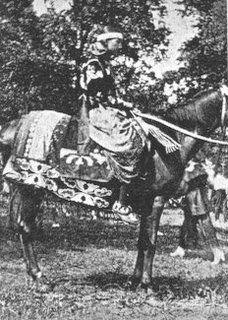 Catherine Stewart took the opportunity, while residing on a Pottawatomie reservation, in the early 1840s, to learn something of the language and to attend a number of activities including a Medicine Dance. As sympathetic as she was to the problems of the Native American populations of the Upper Mississippi she did not come to see them from the inside. Nevertheless, she is a more than normally curious and observant witness. We can only be disappointed that she did not stay for the entire dance.
Catherine Stewart took the opportunity, while residing on a Pottawatomie reservation, in the early 1840s, to learn something of the language and to attend a number of activities including a Medicine Dance. As sympathetic as she was to the problems of the Native American populations of the Upper Mississippi she did not come to see them from the inside. Nevertheless, she is a more than normally curious and observant witness. We can only be disappointed that she did not stay for the entire dance.Of all the religious observances overshadowed by superstition, a Medicine Dance, or Me-ta-me-go-sha of the Pottawattamies, is perhaps the most strange, and not altogether divested of the ludicrous. To witness this extraordinary ceremony, a party, in times past, set out, and surmounting many difficulties in passing through a dense forest, and finally crossing a stream of water on a fallen tree, arrived after dark at the scene of mystic reveling.
Near one of the wigwags of the village, kettles of venison were suspended from poles, over a large fire. Around this festive preparation, groups of Indians were sitting, while others were standing, or moving to and fro.... An Indian woman handing a basket of wild plums to her white visitors, in a measure reassured them, and they forthwith regaled themselves, seated on mats around the fire.
Presently, the drum beat, and raising a piece of bark, which served as a door, they entered a wigwam, where as yet only three persons were assembled. Ne-se-wa-be, the grand high priest, or medicine man, old and attenuated, presided over the ceremonies. He rehearsed some strange jargon, with much fluency, not wholly intelligible to the interpreter; it however, had an allusion to the creation of the world, and events handed down by tradition. He was sitting on a mat with two others, who beat a drum composed of some rude material, and rattled a gourd filled with deer's teeth. With a solemn gravity of mien, their eyes fastened on the ground, they seemed totally absorbed in the solemnity of the occasion.
After some time passed in this way, others having arrived and seated themselves round the fire in the middle of the wigwam; they all rose, men and women, and began to dance with much moderation, to the music of the drum and gourd, never raising their feet, except the heel a little, their heads bending down as if in serious reflection. Old Ne-se-wa-be displayed more agility than anyone else; his adroitness evincing that he was no novice in these ancient mysterious rites. They moved, one after the other, round the fire, some of them holding the skin of a small white animal which they kept in a horizontal position, with the head foremost. When, in this way, it was pointed towards any one outside of the circle, he fell immediately to the ground, all animation apparently suspended.
New Homes in the West by Catherine Stewart. Nashville: Cameron and Fall, 1843. (Readex Microprint, 1966.) 40-44.
Also See:
- Bartram Seeks News of the Creeks and Seminoles. About to ascend the St. John's River, in April of 1774, Wiliam Bartram seeks information about a recent incident between the local settlers and Indians.
- Sidney Lanier on the Fate of the Seminoles. The consumptive poet Sidney Lanier agreed to do a guidebook on Florida, for Lippincott & Co., for $125 per month, travel expenses and the benefit he hoped the excursion would give to his health. Here he deals rather perfunctorily with the fate of the Seminole Indians.
- Seminole Boys Riding Sea Turtles (1890). The only danger is from sharks, which, in the excitement of the chase, they may fail to note the approach of.
- Audubon Observes Florida Sea-Turtles. During an 1832 trip to Florida and the Tortugas, the naturalist James Audubon had the opportunity to study the region's large Turtles...
- Be sure to check out the Browser's Guide to the Library of Babel.



No comments:
Post a Comment